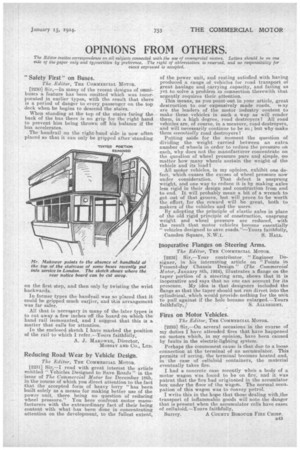OPINIONS FROM OTHERS.
Page 27

If you've noticed an error in this article please click here to report it so we can fix it.
The Editor invites correspondence on all subjects connected with the use of commercial motors. Letters should be on one side of the paper only and typmritten by prefeience, The right of abbreviation is reserved, and no responsibility for views eccpres6ed is accepted.
"Safety First" on Buses.
The Editor, THE COMMERCIAL 110ToB,.
[2230] Sir —In many of the recent designs of omnibuses a feature has been omitted which was incorporated in earlier types, with the result that there is a period of danger to every passenger on the top deck when he begins to descend the stairs.
When standing at the top of the stairs facing the back of the bus there is no grip for the right hand to prevent him being thrown off his balance if the bus accelerates.
The handrail on the right-hand side is now often placed so that it can only be gripped after .standing
on the first step, and then only by twisting the wrist backwards. • In former types the handrail was so placed that it could be gripped much earlier, and this arrangement was far safer.
All that is necessary in many of the later types is to cut away a few inches off the board On which the hand rail is“nounted, and I suggest that this is a matter that calls for attention.
In the enclosed sketch I have marked the position of the rail to which I refer.—Yours faithfully, A. J. MAROWER, Director, MOSSAY AND CO., LTD.
Reducing Road Wear by Vehicle Design.
The Editor, THE COMMERCIAL MOTOR.
[2231] Sir,—I read with great interest the article entitled " Vehicles Designed to Save Roads" in the issue of The Commercial Motor for December lath, in the course of which you direct attention to the fact that the accepted form of heavy lorry "has been built solely as a means for making better use of the power unit, there being no question of reducing wheel pressure." You here confront motor manufacturers with the extraordinary fact of their being content with what has been done in concentrating attention on the development, to the fullest extent, of the power unit, and resting satisfied with having produced a range of vehicles for road transport of great haulage and carrying capacity, and failing as yet to solve a problem in connection therewith that urgently requires their attention.
This means, as you point out in your article, great destruction to our expensively made roads. vs ny are the leaders of the motor industry content to make these vehicles in such a way as will render them, in a high degree, road destroyers ? All road vehicles are, of course, in a measure, road destroyers, and will necessarily continue to be so ; but why make them essentially road destroyers ?
Putting aside for the moment the question of dividing the weight carried between an extra number of wheels in order to reduce the pressure on each, why does not the manufacturer concentrate on the question of wheel pressure pure and simple, no matter how many wheels sustain the weight of the vehicle and its load?
All motor vehicles, in my opinion, exhibit one defect, which causes the excess of wheel pressure now under consideration. That defect is unsprung weight, and one way to reduce it is by making axles less rigid in their design and construction from end to end. It will probably mean a bit of a wrench to get out of that groove, but will prove to be worth the effort, for the reward will be great, both to makers of the vehicles and the users.
By adopting the principle of elastic axles in place of the old rigid principle of construction, unsprung weight and wheel pressure are reduced, with the result that motor vehicles become essentially " vehicles designed to save roads."—Yours faithfully, Camden Square, N.W.1. S. HALL.
Inoperative Flanges on Steering Arms.
The Editor, THE COMMERCIAL MOTOR.
[2232] Sir,—Your contributor " Engineer Designer, in his interesting article on "Points in Present-day Chassis Design" (The Commercial Motor, January Sth, 1924), illustrates a flange on the taper portion of a steering arm, shows that it is inoperative and says that no one can account for its presence. My idea is that designers included the flange so that the taper should not run direct into the cylindrical, which would provide nothing for the unit to pull against if the hole became enlarged.—Yours
f ithf uI ly, S. ALLBRIGHT.
Fires on Motor Vehicles,
The Editor, THE COMMERCIAL MOTOR.
[2233] Sir,—On several occasions in the coarse of my duties I have attended fires that have happened on motors which, in my opinion, have been caused by faults in the electric-lighting system.
Perhaps the commonest cause is that due to a loose connection at the terminal of an accumulator. This permits of arcing, the terminal becomes heated and, in the case of celluloid containers, the material eventually takes fire.
I had a concrete case recently when a body of a, motor wagon was found to be on fire, and it was patent that the fire had originated in the accurnlator box under the floor of the wagdn. The normal occupation of this wagon was to convey petrol.
write this in the hope that those dealing with,the transport of inflammable goods will note the danger that is present when the accumulator cells have cases of celluloid.--Yours faithfully,
Surrey. A COUNTY BOROUGH FIRE CHIEF.






























